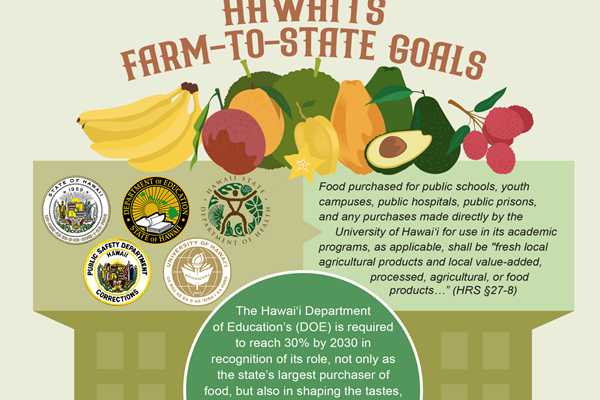Hawaii DOE reports 6.2% of student meals sourced locally
Jan 30, 2023

By the year 2030, the Hawaii Department of Education (HIDOE) will purchase 30% of its produce and meat for student meals from locally sourced vendors—that’s what’s required by Act 175, signed in 2021 (codified as HRS 302A-405.6).
Through HIDOE’s Farm to School (F2S) Program, the department has the potential to leverage its buying power to become one of the state’s largest purchasers of local food (perhaps one day, the largest) while also shaping the taste, attitudes and healthy habits of keiki. The HIDOE Office of Facilities and Operations’ School Food Services Branch recently reported that the total cost of food purchased during the preceding year through October 2022 was $50,518,995. (source: HIDOE).
As of October, the percentage of fresh local agricultural products and local value-added, processed, agricultural, or food products purchased was 6.2%, according to the department’s December 2022 Annual Report on Farm to School Meals.
“If the HIDOE achieves the 30% local benchmark, it would create annual demand of about $15-$20 million for local farmers,” said Jesse Cooke, vice president of investment and analytics of Ulupono Initiative. “This consistent demand will help local farmers scale up production and, as they do so, Hawaii’s food security will increase. Another benefit of the farm-to-school program is that money spent purchasing local food from local farmers stays here in Hawaii and benefits the local economy.”
In addition, continued exposure to fresh foods as the department works toward its goal is not only a win for local farmers but will also have a lasting impact on students.
“When student meals have a high percentage of fresh and local ingredients, the nutritional content and the quality of the meals increase,” Cooke added. “Based on data collected during Farm to School pilot programs done in partnership with school cafeterias in Kohala on the Big Island and in Mililani on Oahu, processed food typically makes up about 80% of the content of student meals. At the end of these pilot programs, processed food content decreased to about 35% of school meals served in Kohala and Mililani.”
The HIDOE expanded on its efforts in its December 2022 report, including the following table that provides a breakdown of the total percentage of local fresh and processed food served by county as measured by the percentage of the total cost of food.
|
For Calendar Year Jan. 1, 2022, to Oct. 31, 2022 |
Oahu |
Hawaii |
Maui |
Molokai |
Lanai |
Kauai |
State |
|
Percentage of Fresh Food Purchase Amount (Local) |
0.97% |
0.57% |
0.26% |
0.01% |
0.01% |
0.10% |
1.92% |
|
Percentage of Processed Food Purchase Amount (Local Beef) |
2.85% |
0.68% |
0.46% |
0.05% |
0.02% |
0.24% |
4.30% |
|
3.82% |
1.25% |
0.72% |
0.06% |
0.03% |
0.34% |
6.22% |
|
For Calendar Year Jan. 1, 2022, to Oct. 31, 2022 |
Oahu |
Hawaii |
Maui |
Molokai |
Lanai |
Kauai |
State |
|
Fresh Food Purchase Amount (Local) |
$490,034 |
$287,958 |
$131,349 |
$5,052 |
$5,052 |
$50,519 |
$969,965 |
|
Processed Food Purchase Amount (Local Beef) |
$1,439,792 |
$343,529 |
$232,387 |
$25,260 |
$10,104 |
$121,246 |
$2,172,317 |
|
$1,929,826 |
$631,488 |
$363,737 |
$30,311 |
$15,156 |
$171,765 |
$3,142,282 |
The department went on to describe a pilot program in April 2022 that provided an average of 1,000 pounds of tossed greens for salads each week to 83 schools in the Honolulu and Windward Oahu school districts. The program expanded to 86 more schools in the Leeward and Central Oahu districts this school year, but due to a heat wave affecting local lettuce, there was a pause on purchasing in the first semester of the 2022-2023 school. The program is expected to resume in the current semester.
Read the HIDOE’s December 2022 Annual Report on Farm to School Meals >>

